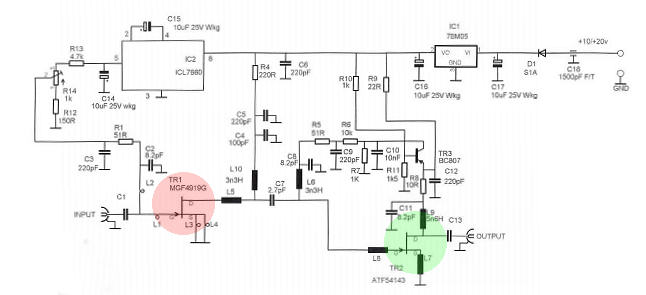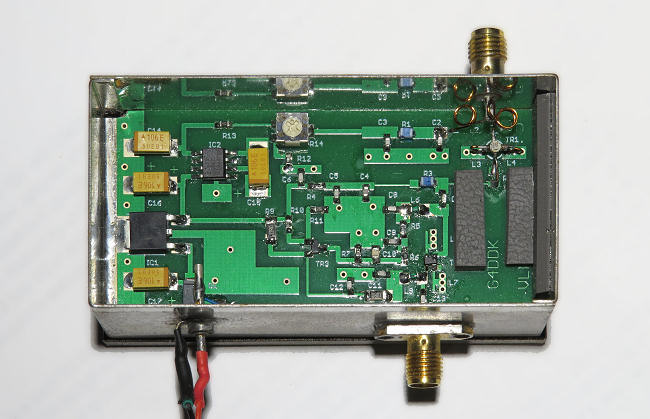G4DDK 1296 Preamp
There are a number of commercially preamps available for 1296 EME operation, ranging in price from under $100 to over $700. I can't give educated opinions on all of them, because I don't own all of them, but I can make a few comments on one. The G4DDK VLNA (very low noise amplifier).A good preamp for 1296 EME use should have a low noise figure, below about 0.3dB is good, and the lower the better. It should also have enough gain to overcome feed line losses, which typically means a two stage amplifier with a gain of >30dB. Wide dynamic range is desirable to avoid intermodulation issues.
The preamp sold by Sam Jewell, G4DDK, meets these requirements. At 1296, the noise figure is <0.3 degrees and the gain is ~ 37.5dB according to the specs.

The basic designs is a very low noise Mitsubishi MGF4919G HEMT as the critical first stage (pink in above schematic), followed by a high dynamic range, low noise, Avago ATF54143 Enhancement Mode Pseudomorphic HEMT second stage (green in above schematic). The input is relatively broadband and low Q. The amplifier can actually be used at 432, 1296, 2304 or 3456 Mhz with only small changes to a few components in the first stage. The broadband input could be an issue if there is was a nearby strong RF source just outside the band. In the USA the closest cell tower frequencies at 850MHZ and 1700Mhz. Unless you live right under one I doubt these would be an issue. I do run a 3 pole interdigital filter after my G4DDK preamp, but I don't need to. Id doesn't seem to make any difference, but I leave it there "just in case".
This is a kit which you build and it includes all the components, connectors and box. Everything you need is in there. It uses SMDs (surface mount devices), so some degree of SMD familiarity is desirable. These are small components and require a steady hand, a fine point soldering iron and thin (0.3mm) solder. Sam provides extensive construction detail and is very willing to help out if you run into problems. Apart from having to do the work to build it, there are some advantages to a kit. You become pretty familiar with the circuit, and if you blow up the first stage by putting too much RF into it(and, speaking from experience, there's a good chance that at some point you probably will), you will know how to replace it!

G4DDK VLNA preamp for 1296. Input is at the upper right
The box (enclosure) is quite "crude" in the sense that it's made from folded metal sheet with a friction fit "top" and "bottom". It's not in a milled-out aluminum water-tight box with gaskets and seals, held together with multiple tiny screws. This, and the fact that it is available as a kiy is the reason why the cost is lower then that of other commercially available preamps. The box, however, is perfectly fine and just the right size to accommodate the PCB. I've been using it outdoors on the dish feed for a couple of years. It's shielded from the direct exposure to the weather weather by an external cover, but otherwise is exposed to the elements. So far it hasn't shown any signs of corrosion or other other negative issues related to weather exposure.
I do not have a noise figure meter and I'm not entirely sure I trust them to set up an LNA anyway. I adjusted the front end of my VLNA with it actually mounted on the feed and tweaked it (i.e. bent the two coils at the input) for best sun noise. With a 3.1m dish I've seen up to 13dB sun noise with the quiet sun and I see >8dB of ground noise. These would lead me to believe the NF of the preamp is in the 0.25dB range. Whatever it is, I'm pretty happy with it! I can certainly recommend this preamp.
The price of the VLNA kit was 58 UK pounds, which was around $80, in Feb 2021. Prices and exchange rates may vary with time. It takes a few hours to build and building is not difficult if you have some experience with surface mount components. To find current price and availability, check Sam's website G4DDK.com
Useful links
.jpg)